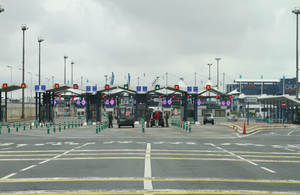Construction begins at revolutionary first secure school
- New world-leading approach to youth custody takes shape
- Education placed at heart of new ‘school within prison walls’ to cut crime and keep our streets safe
- Young people supported into training and jobs upon release
The school – based on the site of the now closed Medway Secure Training Centre in Kent – will see young offenders go straight from the courtroom to the classroom, with every single pupil enrolled in formal education or training and encouraged into further learning or employment on release.
It will be run by education provider Oasis Restore rather than the Prison Service, and inside it will be laid out like a school inside the prison walls. Staff will be trained to offer a broad curriculum and offer one-to-one learning support, and they will set challenging targets in core academic subjects such as English and mathematics. Ofsted inspectors will hold the establishment to the same standards as all other schools nationwide – ensuring the education on offer is of the best possible standard.
Young people will also participate in a weekly programme of rigorous physical education and have the opportunity to work towards sports and leisure qualifications. This will teach important life skills and provide an invaluable asset towards independence and employability.
Since 2012 the number of children in custody has fallen from around 2,000 in 2012 to around 500. These young offenders are around 50 percent more likely to reoffend than adult offenders.
Though wider youth reoffending rates for children who received custodial or community sentences have fallen from 38 percent in 2012 to 34 percent in 2022 they stubbornly remain nearly 9 percentage points higher than adult reoffending.
They are also much more likely to have had a disrupted a disrupted education. 60 percent are not engaged in education before entering custody due to truancy, suspension, or expulsion, meaning they have lost out on months’ or years’ worth of learning which would have given them the opportunities to steer clear of a life of crime.
Around eight in 10 prolific adult offenders begin committing crimes as children, with the estimated cost to the taxpayer around £17 billion per year.
Deputy Prime Minister, Lord Chancellor & Secretary of State for Justice, Dominic Raab MP, said:
This secure school is a first. It’s effectively a school with prison walls around it that will give the stubborn hard core of young offenders, who need to be in custody, the tailored curriculum and mental health support they need to turn away from crime and get into training and work.
It’s the right thing to do for them and the public, driving down reoffending, and making our streets safer.
The design of the new school is based on international, peer-reviewed research which shows that smaller settings, high-quality education and healthcare provision, and a specialised workforce of teachers and youth workers are vital to successfully rehabilitating young people in custody.
The old prison-style features at Medway have been stripped out and the finished site will look like a residential school rather than a custodial facility, within secure prison walls.
It will house 49 children when full, and will include state-of-the-art, bar-less windows as well as the latest secure in-room technology which will allow children to continue homework and projects in their rooms, organise their routines and contact their families in a safe and secure way.
Construction work will continue until autumn 2023 when the site will be handed over to specialist education provider and operator Oasis Restore, with the first pupils expected to arrive in 2024.
The Rev Steve Chalke MBE, Founder of Oasis, said:
For too long society has bought into the idea that punishing young people will somehow benefit them. All the research shows this does not work. You can’t help a child by harming them. You can’t take children who have been wounded psychological and somehow hope that punishment will heal them. Then, when you release them, wonder why so many reoffend.
Oasis is not trying to ignore a young person’s crime, or to minimise the pain of their victim and family. But, it’s time for a revolution in youth justice. And, we’re excited that Oasis Restore – the country’s first secure school – with an emphasis on therapeutic care, education and positive settlement into life beyond our gates, which enables them to thrive – will be that revolution.
The school’s core focus on getting troubled young people into jobs or further education is part of the Government’s ambitious plan to further drive down reoffending – following a five per cent fall over the last decade.
The construction of the new school builds on the Government’s commitments under the Prison Strategy White Paper to drive up standards of adult education in custody, while also tackling drug and alcohol addiction and ensuring offenders are ready for work on release.
Notes to editors
- Read more about the Prisons Strategy White Paper
- Since 2012 reoffending rates have decreased from 30.9% to 25.6%.
- Reoffending among children has fallen by around 4 percentage points (from 38.3% to 34.2%).
- The number of under-18s in custody has gone down from 1,966 in the year ending March 2012 to 454 in the year ending March 2022.
- The latest annual figures from 2019/20 show that young people have a 63.7% risk of reoffending when they leave custody compared to 42% of adult prisoners.
- Learn more about Oasis Restore by visiting www.oasisrestore.org or via Twitter at www.twitter.com/OasisRestore
- Apply to become a teacher or youth worker at Oasis Restore

